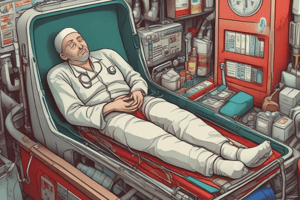Podcast
Questions and Answers
What is the primary purpose of gastric lavage?
What is the primary purpose of gastric lavage?
- To immobilize the injured area
- To remove toxic substances from the stomach (correct)
- To provide fresh air for inhalation poisonings
- To hydrate the patient after poisoning
What should you do first in the event of an electrical injury?
What should you do first in the event of an electrical injury?
- Provide rescue breaths
- Turn off the power source (correct)
- Call emergency services immediately
- Check for burns on the patient
Which of the following symptoms is associated with snake and insect bites?
Which of the following symptoms is associated with snake and insect bites?
- Persistent coughing
- Systemic reactions like anaphylaxis (correct)
- Severe headaches
- Nausea and vomiting
What is the first action to take in extreme situations like traffic accidents or fires?
What is the first action to take in extreme situations like traffic accidents or fires?
What is a common symptom of barotrauma?
What is a common symptom of barotrauma?
What is a common symptom of gastrointestinal disorders?
What is a common symptom of gastrointestinal disorders?
What should be avoided in cases of acute abdominal pain syndrome?
What should be avoided in cases of acute abdominal pain syndrome?
What is a potential cause of gastrointestinal bleeding?
What is a potential cause of gastrointestinal bleeding?
Which symptom is associated with renal colic?
Which symptom is associated with renal colic?
What should be done for a patient experiencing life-threatening CNS conditions?
What should be done for a patient experiencing life-threatening CNS conditions?
What is a common cause of loss of consciousness?
What is a common cause of loss of consciousness?
Which type of seizure is characterized by a focal onset?
Which type of seizure is characterized by a focal onset?
What is an appropriate first aid response for someone experiencing hallucinations?
What is an appropriate first aid response for someone experiencing hallucinations?
Which category of medical waste requires the use of puncture-resistant containers for disposal?
Which category of medical waste requires the use of puncture-resistant containers for disposal?
What is one key preventative measure to reduce occupational infections in medical workers?
What is one key preventative measure to reduce occupational infections in medical workers?
What should be done immediately after exposure to contaminated materials?
What should be done immediately after exposure to contaminated materials?
Which of the following is NOT a key step in first aid organization?
Which of the following is NOT a key step in first aid organization?
During a detailed assessment of a patient, which of the following should NOT be prioritized?
During a detailed assessment of a patient, which of the following should NOT be prioritized?
What essential item is included in a well-stocked first aid kit?
What essential item is included in a well-stocked first aid kit?
Which action should be taken first when addressing a critical condition?
Which action should be taken first when addressing a critical condition?
What should be included in training for waste management in hospitals?
What should be included in training for waste management in hospitals?
What is a primary step to take when dealing with acute respiratory failure?
What is a primary step to take when dealing with acute respiratory failure?
Which condition is characterized by coughing up blood?
Which condition is characterized by coughing up blood?
What is an important precaution when using an inhaler?
What is an important precaution when using an inhaler?
What should be done immediately if a patient exhibits sudden cardiac arrest?
What should be done immediately if a patient exhibits sudden cardiac arrest?
What is a common sign of acute heart failure?
What is a common sign of acute heart failure?
Which is NOT a sign of life-threatening cardiovascular conditions?
Which is NOT a sign of life-threatening cardiovascular conditions?
What should be done for a patient with hemoptysis?
What should be done for a patient with hemoptysis?
What is required during cardiovascular resuscitation?
What is required during cardiovascular resuscitation?
When is a first aider required to obtain consent?
When is a first aider required to obtain consent?
What is implied consent in emergency situations?
What is implied consent in emergency situations?
Which ethical principle emphasizes a patient's right to make choices regarding their care?
Which ethical principle emphasizes a patient's right to make choices regarding their care?
What defines medical asepsis?
What defines medical asepsis?
What is the primary treatment for a clean wound?
What is the primary treatment for a clean wound?
Which type of antiseptic is designed to kill bacteria?
Which type of antiseptic is designed to kill bacteria?
Which type of burn is characterized by blisters?
Which type of burn is characterized by blisters?
What is a Do-Not-Resuscitate (DNR) order?
What is a Do-Not-Resuscitate (DNR) order?
Which of the following symptoms is NOT associated with dehydration?
Which of the following symptoms is NOT associated with dehydration?
What is the appropriate first aid for frostbite?
What is the appropriate first aid for frostbite?
Healthcare-associated infections (HAIs) are defined as?
Healthcare-associated infections (HAIs) are defined as?
What is the first step in managing a patient with dyspnea?
What is the first step in managing a patient with dyspnea?
When should a first aider cease their responsibilities?
When should a first aider cease their responsibilities?
What initial steps should be taken for a patient experiencing heatstroke?
What initial steps should be taken for a patient experiencing heatstroke?
Which response is NOT a common sign of life-threatening respiratory conditions?
Which response is NOT a common sign of life-threatening respiratory conditions?
What is a key part of first aid for burns?
What is a key part of first aid for burns?
Flashcards
Wound Care Basics
Wound Care Basics
Clean wounds with antiseptic and cover with a sterile dressing.
Primary Treatment for Wounds
Primary Treatment for Wounds
Ensuring the patient receives tetanus prophylaxis if necessary.
First Degree Burn
First Degree Burn
The outermost layer of skin is affected, resulting in redness, pain, and no blisters.
Second Degree Burn
Second Degree Burn
Signup and view all the flashcards
Third Degree Burn
Third Degree Burn
Signup and view all the flashcards
Sunburn
Sunburn
Signup and view all the flashcards
Dehydration
Dehydration
Signup and view all the flashcards
Heatstroke
Heatstroke
Signup and view all the flashcards
Beneficence
Beneficence
Signup and view all the flashcards
Non-maleficence
Non-maleficence
Signup and view all the flashcards
Autonomy
Autonomy
Signup and view all the flashcards
Justice
Justice
Signup and view all the flashcards
Aseptic Techniques
Aseptic Techniques
Signup and view all the flashcards
Asepsis
Asepsis
Signup and view all the flashcards
Antiseptics
Antiseptics
Signup and view all the flashcards
Healthcare-Associated Infections (HAIs)
Healthcare-Associated Infections (HAIs)
Signup and view all the flashcards
Acute Respiratory Failure
Acute Respiratory Failure
Signup and view all the flashcards
What is acute respiratory failure?
What is acute respiratory failure?
Signup and view all the flashcards
Inhaler
Inhaler
Signup and view all the flashcards
Hemoptysis
Hemoptysis
Signup and view all the flashcards
Pulmonary Hemorrhage
Pulmonary Hemorrhage
Signup and view all the flashcards
Acute Heart Failure
Acute Heart Failure
Signup and view all the flashcards
Sudden Cardiac Arrest
Sudden Cardiac Arrest
Signup and view all the flashcards
Cardiovascular Resuscitation (CPR)
Cardiovascular Resuscitation (CPR)
Signup and view all the flashcards
What are the categories of medical waste?
What are the categories of medical waste?
Signup and view all the flashcards
How should medical waste be handled?
How should medical waste be handled?
Signup and view all the flashcards
How can risks associated with medical waste be minimized?
How can risks associated with medical waste be minimized?
Signup and view all the flashcards
What are the risks to medical workers from occupational infections?
What are the risks to medical workers from occupational infections?
Signup and view all the flashcards
What are some preventative measures against occupational infections?
What are some preventative measures against occupational infections?
Signup and view all the flashcards
What should be done following exposure to potentially infectious material?
What should be done following exposure to potentially infectious material?
Signup and view all the flashcards
What are the key steps in first aid organization?
What are the key steps in first aid organization?
Signup and view all the flashcards
What are some initial actions in first aid?
What are some initial actions in first aid?
Signup and view all the flashcards
What is acute abdominal pain syndrome?
What is acute abdominal pain syndrome?
Signup and view all the flashcards
What is renal colic?
What is renal colic?
Signup and view all the flashcards
What are the symptoms of life-threatening CNS conditions?
What are the symptoms of life-threatening CNS conditions?
Signup and view all the flashcards
What is loss of consciousness?
What is loss of consciousness?
Signup and view all the flashcards
What are common signs of gastrointestinal disorders?
What are common signs of gastrointestinal disorders?
Signup and view all the flashcards
What is Barotrauma?
What is Barotrauma?
Signup and view all the flashcards
What is Gastric Lavage?
What is Gastric Lavage?
Signup and view all the flashcards
What are some causes of gastrointestinal bleeding?
What are some causes of gastrointestinal bleeding?
Signup and view all the flashcards
What are nervous system disorders?
What are nervous system disorders?
Signup and view all the flashcards
What is First Aid in Extreme Situations?
What is First Aid in Extreme Situations?
Signup and view all the flashcards
What are Electrical Injuries?
What are Electrical Injuries?
Signup and view all the flashcards
What are hallucinations and delirium?
What are hallucinations and delirium?
Signup and view all the flashcards
What are the symptoms of Snake and Insect Bites?
What are the symptoms of Snake and Insect Bites?
Signup and view all the flashcards
Study Notes
Historical Origins of First Aid
- First Aid was formalized in 1879 in the UK by St. John Ambulance.
- It dates back to 1099 when the Order of St. John trained knights to provide battlefield care.
Evolution of First Aid
- The Red Cross was founded after the First Geneva Convention (mid-1800s) to aid wounded soldiers and provide basic training.
- Prussian surgeon Friedrich von Esmarch introduced the term "erste hilfe" (first aid) during the Franco-Prussian War (1870).
- Ambulance crews in Britain were trained for specific emergencies like railway, mining, and police incidents.
Terminology
- The term "first aid" emerged in 1878, combining "first treatment" and "National Aid."
- First aid is now described as initial care for illness or injury, aimed at preserving life, preventing further harm, or promoting recovery, for use by properly trained individuals.
Types of Medical Care
- Primary Care: General health management and disease prevention (check-ups, diagnosis, referral to specialists).
- Specialty Care: Focused care for specific conditions or body systems (cardiology, gynecology, physiotherapy).
- Emergency Care: Immediate treatment for life-threatening situations (heart attack, severe bleeding).
- Urgent Care: Addresses non-life-threatening but immediate needs (minor cuts, burns, infections).
- Long-Term and Hospice Care: Long-term care supports daily living, hospice care focuses on palliative care for terminal illnesses.
- Mental Health Care: Treatment for mental illnesses and emotional crises (psychotherapy and medication).
Studying That Suits You
Use AI to generate personalized quizzes and flashcards to suit your learning preferences.




